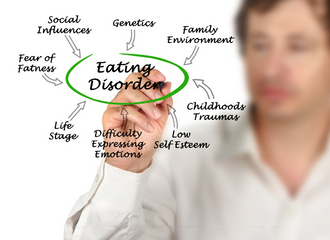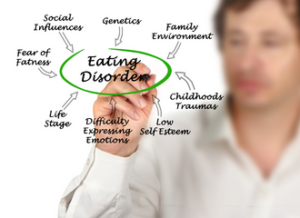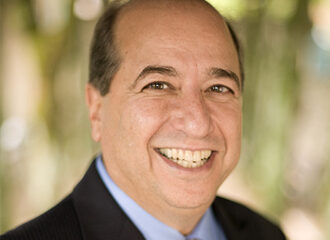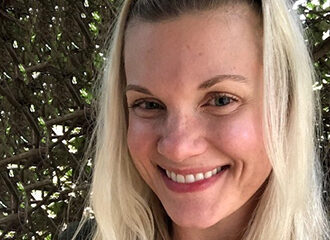Eating disorders affect about 9% of the population, both worldwide and in the U.S, and are one of the deadliest psychiatric and emotional illnesses. Understanding these disorders – the different types, their symptoms, their diagnosing criteria, and their various treatments – helps save lives.
Eating disorders are very serious and affect both your physical and mental health. You may suspect that someone you know is suffering from an eating disorder, but because people with eating disorders are often in denial, it’s hard to be certain. It could be your sibling, parent, friend, or roommate. The person may try to hide it, but the focus of their everyday life revolves—obsessively—around food, weight, and shape.
These obsessive thoughts and compulsive behaviors can take many forms. Some people try to starve themselves by restricting their intake. Some may eat large amounts of food in an uncontrolled, frenzied way, beyond the point of being physically full. Others may binge and then compensate by purging. In this post we will break down the different types of eating disorders, the treatment available and how to support someone struggling.
What are eating disorders?
An eating disorder is a psychiatric condition in which there is a persistent disturbance of eating or eating related behaviors that often results in medical, psychological, and social impairment. They are complex illnesses with biological, genetic, psychological, social, and developmental roots. Eating disorders aren’t just about food and weight; they’re also emotional disorders.
What are the different types of eating disorders?
The most common eating disorders are binge-eating disorder, bulimia, anorexia, and other specified feeding or eating disorder (OSFED).
Binge Eating Disorder
People with Binge Eating Disorder (BED) engage in binge eating episodes. They eat large amounts of food in a discrete period of time, often feeling out of control and past feeling full. Those struggling with binge-eating disorder often experience a great deal of shame with their behaviors and unlike bulimia, they do not compensate for the food intake. The binge eating occurs, on average, at least once a week for 3 months.
Bulimia
Individuals with Bulimia Nervosa (BN) engage in cycles of binge eating and purging behaviors to compensate for binge eating episodes. The purging associated with bulimia may take many forms including self-induced vomiting, excessive use of laxatives or diuretics, or compulsive exercising. The binge eating and purging behaviors occur, on average, at least twice a week for 3 months.
Anorexia
Those who struggle with Anorexia Nervosa (AN) and Atypical Anorexia Nervosa (diagnosed as OSFED; more on that below) purposefully restrict their intake, which leads to significant weight loss and/or a significantly low body weight in the context of age, developmental trajectory, and physical health. These individuals have an intense fear of gaining weight and high levels of body dissatisfaction regardless of weight, shape, or body size. Those with AN binge/purge type also engage in binge eating episodes and/or purging.
OSFED
Finally, Other Specified Feeding or Eating Disorder (OSFED) is a diagnosis given to those who do not meet the strict diagnostic criteria for AN, BN, or BED, but report behaviors and symptoms severe enough to cause impairment across various domains.
Who suffers from eating disorders?
Eating disorders do not discriminate – they affect all ages, genders, socioeconomic statuses, cultures, body sizes, or sexual orientations. They are often diagnosed in teenagers and young adults, but many people are first diagnosed with an eating disorder in later adulthood. Sometimes the first signs and symptoms develop at a much younger age.
Who diagnoses an eating disorder?
It is critical to understand that eating disorders are not just fads, phases, lifestyle choices, or trivial eccentricities. They are extremely serious disorders that have one of the highest mortality rates in the DSM-V (second only to Opioid Use Disorder). Patients with eating disorders deserve and require professional assessment, diagnosis, and treatment.
If you suspect you or a loved one is struggling with an eating disorder, a thorough assessment by a qualified eating disorder provider, such as a licensed therapist, psychologist, psychiatrist, or primary care physician (PCP) would be necessary to confirm a diagnosis and recommend a level of care that best matches your needs.
What kind of treatment is available for eating disorders?
Eating disorders are ideally caught early and treated thoroughly at the appropriate level of care with a qualified multidisciplinary treatment team. Levels of care can range from weekly appointments with an outpatient team, an intensive outpatient program (IOP), a partial hospitalization program (PHP), a residential program (RES), or in severe cases, an inpatient hospitalization setting (IP).
The Renfrew Center is unique among eating disorder treatment centers in offering not only inpatient programs, but a full continuum of care. This comprehensive range of services is tailored to each patient, with input from their referring therapist, to develop treatment plans and goals based on the specific needs identified.
How do you know if you have an eating disorder?
The warning signs of an eating disorder can be easily missed in a culture obsessed with health, fitness, and weight loss. It’s important to recognize the early warning signs and symptoms. It’s important to remember that eating disorders don’t have a “look” and many signs and symptoms cannot be observed on the outside. Possible warning signs may include:
- Fluctuations in weight
- Obsessing over food/calories, body size and shape, and exercise
- Developing and adhering rigidly to specific food or exercise rules, routines, and rituals
- Disappearing after meals
- Wearing baggy clothes to hide their body
- Eliminating foods or decreasing food variety
- Hiding or hoarding food
- Eating in secret/isolation
- Eating more/less than usual, or at a slower or faster pace
- Engaging in a lot of baking or cooking for others
- Isolating; withdrawing from friends and activities
- Menstrual irregularities
- Other physiological signs including cold hands/swollen feet; dehydration; dry skin/hair; discoloration of teeth or cavities; impaired immune function; swelling around salivary glands; difficulty concentrating; fainting; GI complaints; and sleep disturbances
What should you do if you think you have an eating disorder?
The road to recovery from an eating disorder starts with admitting there’s a problem. Here are some steps you can take if you think you’re developing an eating disorder:
- If you are fortunate enough to access care, schedule an assessment with a qualified medical or mental health provider or respected treatment facility. NEDA provides a free screening tool on their website (https://www.nationaleatingdisorders.org/screening-tool) and a helpline (800) 931-2237.
- Educate yourself about eating disorders. The National Eating Disorder Association (https://www.nationaleatingdisorders.org/learn) website or the Renfrew website (https://www.renfrewcenter.com) can be places to start.
- Talk to a trusted friend/loved one. Eating disorders thrive in secrecy. Let someone know you’re struggling.
- Ask for support. You don’t have to do this alone. Practice asking for what you need and accepting help from others.
- Learn about your treatment options, such as program locations and levels of care (https://renfrewcenter.com/services/)
- Give yourself permission to prioritize your recovery. Treatment often requires resources, time and effort. Identify what you’re willing and able to pause, postpone, or delegate to others to focus on your recovery.
Conclusion
Eating disorders can be devastating to the mind, body and spirit. People with eating disorders typically struggle with intense emotional experiences, anxiety, depression, and poor body image. No matter how much you may care for a person, you cannot fix those things. Your support can help tremendously, but you or your loved one also deserve treatment by expert physicians, therapists, and dieticians, as well as the support found among a community of recovering peers.
Once an eating disorder has been recognized, it can be treated. If you believe someone you know may have an eating disorder, you can help save their life—with a call to The Renfrew Center at 1-800-RENFREW.




